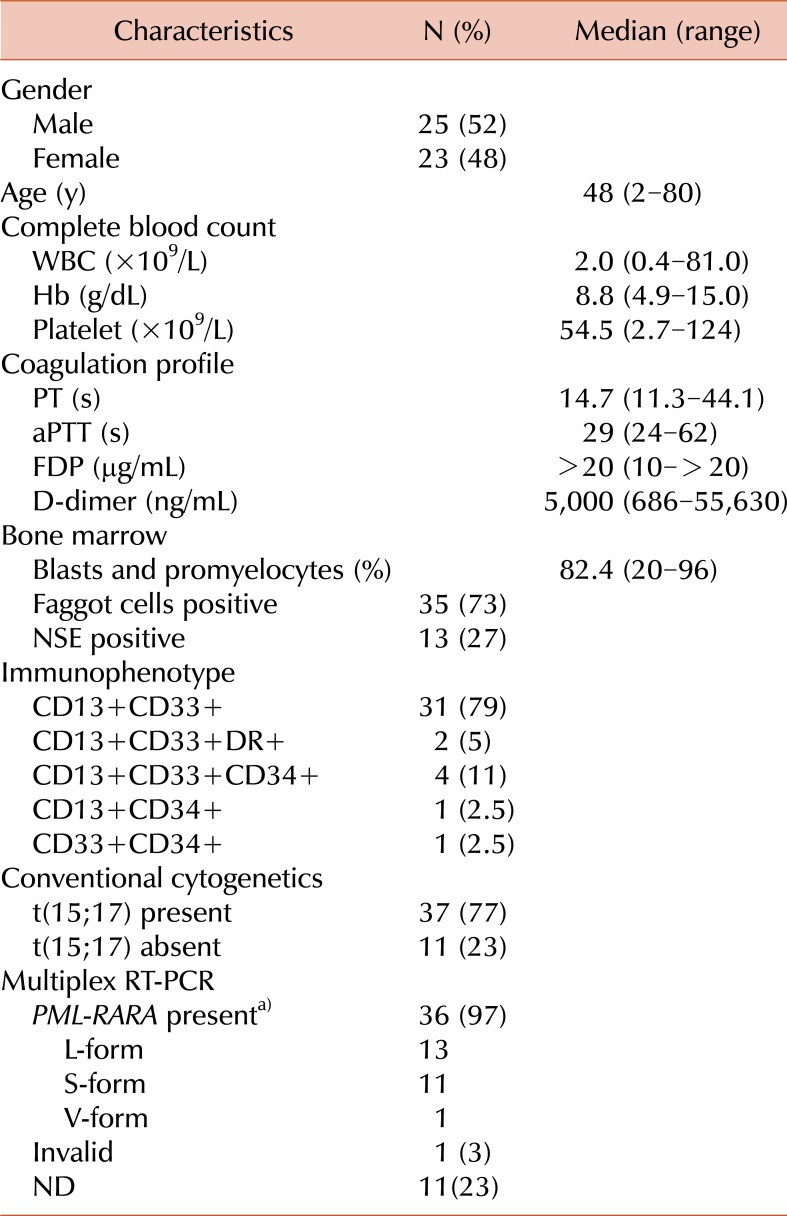1. Bennett JM, Catovsky D, Daniel MT, et al. A variant form of hypergranular promyelocytic leukaemia (M3). Br J Haematol. 1980; 44:169–170. PMID:
6929699.

2. Zhu J, Koken MH, Quignon F, et al. Arsenic-induced PML targeting onto nuclear bodies: implications for the treatment of acute promyelocytic leukemia. Proc Natl Acad Sci U S A. 1997; 94:3978–3983. PMID:
9108090.

3. Huang ME, Ye YC, Chen SR, et al. Use of all-trans retinoic acid in the treatment of acute promyelocytic leukemia. Blood. 1988; 72:567–572. PMID:
3165295.

4. Swerdlow SH, Campo E, Harris NL, editors. WHO classification of tumours of haematopoietic and lymphoid tissues. 2008. 4th ed. Lyon, France: IARC;p. 112–114.
5. Pandolfi PP, Alcalay M, Fagioli M, et al. Genomic variability and alternative splicing generate multiple PML/RAR alpha transcripts that encode aberrant PML proteins and PML/RAR alpha isoforms in acute promyelocytic leukaemia. EMBO J. 1992; 11:1397–1407. PMID:
1314166.

6. Castaigne S, Chomienne C, Daniel MT, et al. All-trans retinoic acid as a differentiation therapy for acute promyelocytic leukemia. I. Clinical results. Blood. 1990; 76:1704–1709. PMID:
2224119.
7. Warrell RP Jr, Frankel SR, Miller WH Jr, et al. Differentiation therapy of acute promyelocytic leukemia with tretinoin (all-trans-retinoic acid). N Engl J Med. 1991; 324:1385–1393. PMID:
1850498.

8. Hillestad LK. Acute promyelocytic leukemia. Acta Med Scand. 1957; 159:189–194. PMID:
13508085.
9. Stein E, McMahon B, Kwaan H, Altman JK, Frankfurt O, Tallman MS. The coagulopathy of acute promyelocytic leukaemia revisited. Best Pract Res Clin Haematol. 2009; 22:153–163. PMID:
19285282.

10. Cho SR, Park SJ, Kim HJ, et al. Acute promyelocytic leukemia with complex translocation t(5;17;15)(q35;q21;q22): case report and review of the literature. J Pediatr Hematol Oncol. 2011; 33:e326–e329. PMID:
21617563.
11. Avvisati G, Lo-Coco F, Paoloni FP, et al. AIDA 0493 protocol for newly diagnosed acute promyelocytic leukemia: very long-term results and role of maintenance. Blood. 2011; 117:4716–4725. PMID:
21385856.

12. Sanz MA, Montesinos P, Rayon C, et al. Risk-adapted treatment of acute promyelocytic leukemia based on all-trans retinoic acid and anthracycline with addition of cytarabine in consolidation therapy for high-risk patients: further improvements in treatment outcome. Blood. 2010; 115:5137–5146. PMID:
20393132.

13. Creutzig U, Harbott J, Sperling C, et al. Clinical significance of surface antigen expression in children with acute myeloid leukemia: results of study AML-BFM-87. Blood. 1995; 86:3097–3108. PMID:
7579404.

14. Lee WS, Lee SM, Lee KH, et al. Clinical significance of PML/RAR alpha isoforms in acute promyelocytic leukemia. Korean J Med. 2008; 75:412–419.
15. Yi HG, Lim JH, Kim JS, et al. Ten-year experience on acute promyelocytic leukemia at Inha University Hospital. Korean J Hematol. 2006; 41:289–296.

16. Frankel SR. Acute promyelocytic leukemia. New insights into diagnosis and therapy. Hematol Oncol Clin North Am. 1993; 7:109–138. PMID:
8449855.

17. Drexler HG. Classification of acute myeloid leukemias-a comparison of FAB and immunophenotyping. Leukemia. 1987; 1:697–705. PMID:
3312833.
18. Park JS, Yi JW, Jeong SH, et al. Comparison of multiplex reverse transcription polymerase chain reaction and conventional cytogenetics as a diagnostic strategy for acute leukemia. Int J Lab Hematol. 2008; 30:513–518. PMID:
18983303.

19. Diverio D, Riccioni R, Mandelli F, Lo Coco F. The PML/RAR alpha fusion gene in the diagnosis and monitoring of acute promyelocytic leukemia. Haematologica. 1995; 80:155–160. PMID:
7628753.
20. Cervera J, Montesinos P, Hernandez-Rivas JM, et al. Additional chromosome abnormalities in patients with acute promyelocytic leukemia treated with all-trans retinoic acid and chemotherapy. Haematologica. 2010; 95:424–431. PMID:
19903674.

21. De Botton S, Chevret S, Sanz M, et al. Additional chromosomal abnormalities in patients with acute promyelocytic leukaemia (APL) do not confer poor prognosis: results of APL 93 trial. Br J Haematol. 2000; 111:801–806. PMID:
11122141.

22. Tallman MS, Nabhan C, Feusner JH, Rowe JM. Acute promyelocytic leukemia: evolving therapeutic strategies. Blood. 2002; 99:759–767. PMID:
11806975.

23. Sanz MA, Tallman MS, Lo-Coco F. Tricks of the trade for the appropriate management of newly diagnosed acute promyelocytic leukemia. Blood. 2005; 105:3019–3025. PMID:
15604216.

24. Yanada M, Matsushita T, Asou N, et al. Severe hemorrhagic complications during remission induction therapy for acute promyelocytic leukemia: incidence, risk factors, and influence on outcome. Eur J Haematol. 2007; 78:213–219. PMID:
17241371.

25. Dekking E, van der Velden VH, Bottcher S, et al. Detection of fusion genes at the protein level in leukemia patients via the flow cytometric immunobead assay. Best Pract Res Clin Haematol. 2010; 23:333–345. PMID:
21123134.

26. Di Bona E, Avvisati G, Castaman G, et al. Early haemorrhagic morbidity and mortality during remission induction with or without all-trans retinoic acid in acute promyelocytic leukaemia. Br J Haematol. 2000; 108:689–695. PMID:
10792270.







 PDF
PDF ePub
ePub Citation
Citation Print
Print



 XML Download
XML Download